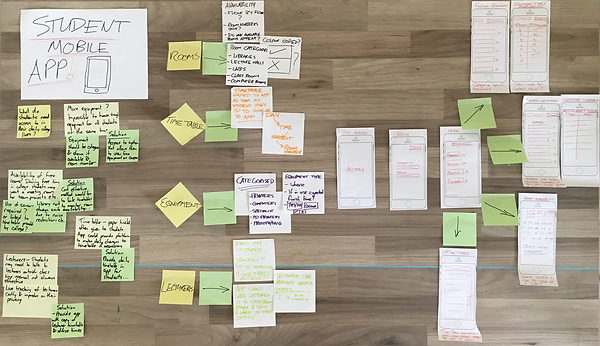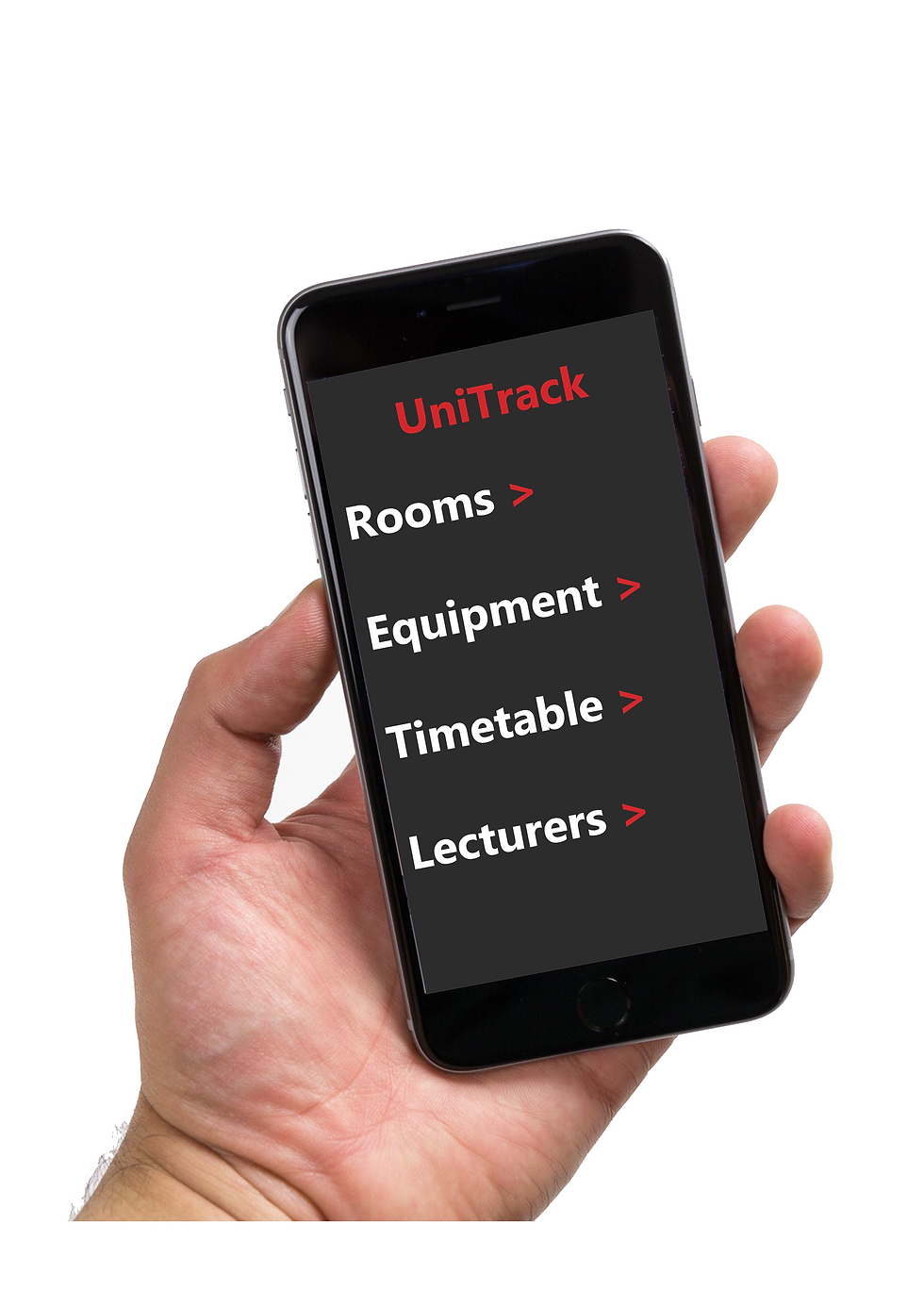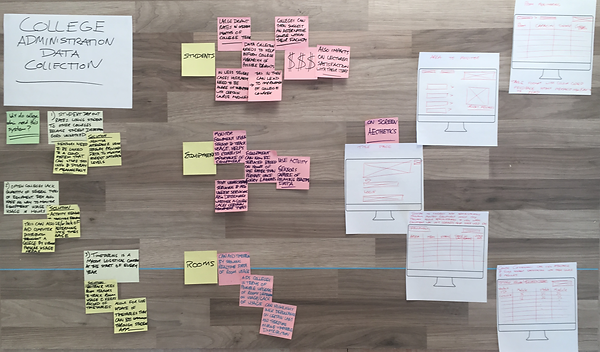
UniTrack
Solution
Our solution, is UniTrack. UniTrack is a data collection, cloud, application and sensor based system that allows college faculties to track everyday college happenings such as module attendance and equipment and room usage. UniTrack also comes with an app for students and lecturers, allowing for students to view realtime data such as college equipment that is not in use along with free rooms and also lecturer timetables.
Activity sensors monitor the usage of computers, 3D printers and other tools used around the college campus. These sensors send information regarding usage to the database and cloud systems for review by college administration. It allows them to view what items are currently in use, when they were last serviced, hours in use since last service and recommends action to take. With this information, college administration can see if equipment is being over-run with work and perhaps may need to purchase another piece of the same equipment. On the flip side they can also see if equipment is not needed in the collge by viewing its usage.
Sensors
The use of a variety of sensors is the foundation on which the rest of the UniTrack system is built. Sensors, mapped around the educational institutions building are connected to both a cloud and an application.

Sensors in the doorways of rooms and lecture halls map whether or not the room is in use by sensing if someone has walked into the room. This information is relayed to the student app and also to college administration. These sensors also link to a persons student ID. When the sensor reads the students card simply by the student walking past it, it records the students identification number and sends it to the cloud. This can then be used by the college administration to gauge student attendance and satisfaction with their course.


Colleges currently have no access to a system that allows them to monitor equipment, room usage outside of timetabled hours, student attendance and module popularity.

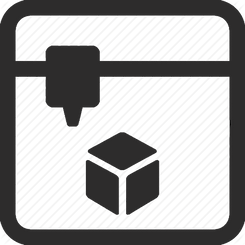
Activity sensors monitor equipment use such as computers and 3D printers. This information is then relayed to the student app and the college administration cloud database. With this system students can now save time by viewing their app and seeing what equipment is available and where the available equipment is located. College administration can now see what equipment is being used and how often it is used.
Data Collection & Cloud
UniTrack's data collection and cloud based system relies on information gathered by the sensors mapped around the college. This information includes student attendance, equipment usage and room usage.

The data collection and cloud aspect of UniTrack is designed to be accessed only by college administration. Sensors mapped around the college link to the students college ID and record their attendance. With dropout rates as high as 33% for some courses it is important that college administration can spot if a student is unhappy in their course. It is also important that they can see how certain modules are performing and whether or not they need to make any changes. In this image you can see that one student in particular does not attend class often, but appears to have an interest in the theory aspect of their course. In this instance college administration could suggest a new course to them based on their interest, before perhaps, the student decides to pursue a course in a different college or drop out altogether.
It is also clear from the image that one module is falling behind in terms of attendance. The college administration could look and see whether this module is directed specifically towards this course or if any changes could be made to improve attendance.
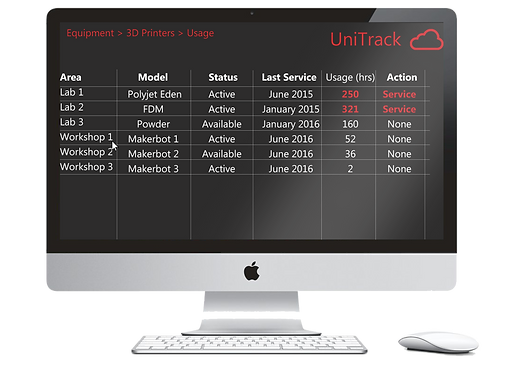

Similar to equipment tracking, UniTrack monitors activity in rooms to inform both the cloud and app systems whether a room is available for use or not. College administration using the cloud system can use this tool when mapping out course timetables or in the event a timetable needs to be adjusted. Timetables for each room are also stored on the system.
Student App
As mentioned previously, the student application allows students to view available rooms and equipment. This helps increase student productivity by reducing the amount of time spent trawling through college buildings searching for free rooms & equipment. Once logged in, Unitrack then stores the students own timetable and also stores timetables of lecturers of that student. This allows the student to locate lecturers throughout the day and not just when they are timetabled to have them for class. This may be particularly important to students starting off in college who may be struggling with a particular topic, or even final year students looking for help with their thesis topic.
-
Sean
-
18
-
First year of college
-
Poor class attendance
-
Unhappy with his course choice
-
Afraid to speak to college staff about his issue
User Profiling
-
Gráinne
-
48
-
Course co-ordinator
-
Finds timetabling and scheduling of classes extremely difficult
-
In charge of equipment budget and usage, while also monitoring student satisfaction
-
Jane
-
23
-
Final year of college
-
Depends on college pc's for course specific programs
-
Often spends up to 30 mins searching for a free computer
-
Peter
-
51
-
Workshop Technician
-
Oversees use of equipment such as 3D printers
-
Struggles to log hours of use with such high volumes of equipment usage
What if you could locate and track people and objects within an educational institute. What sort of innovative applications or solutions would you suggest that could directly impact students and faculty collaboration and productivity?
The Brief
*Having completed the day long event I pursued the idea further on an individual basis. While the theoretical idea behind UniTrack was compiled as a team, all graphical and visual concepts seen below are my own.




UniTrack stemmed from a day long event ran by IBM in conjunction with DIT. It was labelled "The Internet of Things Enterprise Challenge". The idea of this challenege was to gather students from various disciplines and team them up to create solutions to real world challenges. The teams would then work together for the day to come up with solutions and present their idea. Our team was awarded with prizes for best solution and best presentation
Research
While, as students we were all too aware of some of the issues in third level institutes, we were also aware that the majority of students would not be willing to pay for any solutions. We needed to think of a way to pitch our idea to college administrations, in such a way that they would feel compelled to employ our solution in their institution. The infographic below demonstrates issues from both the educational institution and students perspective
























-
Unclear career aspirations
-
Lack of information and guidance on course and career options
-
Unsuitable course choice
-
Difficulties with some of the subjects taken
-
Poor communication between staff and students
-
Different drop out rates in different course areas
-
Financial and work-related problems
HEA Report: Factors Identified
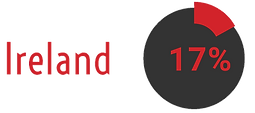

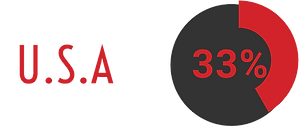
Approximately 350,000 students enter third level education in the U.K each year.
There are 210,000 college students in the Republic of Ireland.(2015)
The US has one of the highest college dropout rates in the world.
Direct communication, particularly in large colleges, between students and lecturers is minimal, making it difficult for problems to be resolved
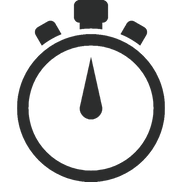
College students have indicated frustrations with inability to easily find unused equipment, particularly during busy periods. They have also indicated difficulties in finding spare rooms to conduct meetings during group based assignments, resulting in valuable time wasted.
